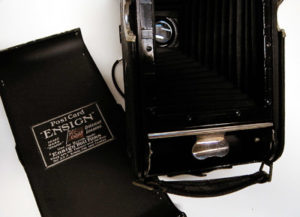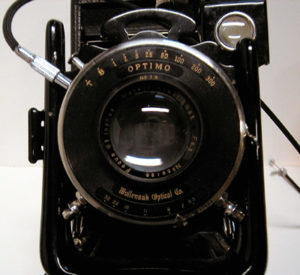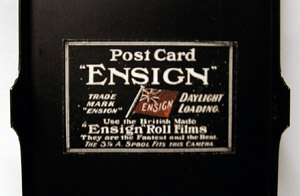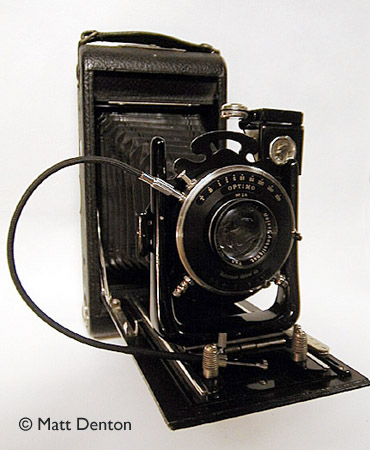- Produced says ‘Patent June 14, 1910’ (1914?) Houghton Ltd., London
- Film type 3 1/4 rollfilm (122 I’m pretty sure)
- Picture size 3 1/4 x 5 1/2
- Weight 2lbs, 10.5oz (1kg, 204.9g)
- Lens Meteor Anastigmat focus 6 3/4 inches, f6.3 (stops to f32)
- Focal range 5′ to infinity
- Shutter Wollensak Optimo 1a
- Shutter speeds T, B, 1, 2, 5, 25, 50, 100, 200, 300
- Viewfinder collapsible mirror type
- Exposure meter none
- bubble level…!
Overview
I know very little about this camera except that it is a beautiful example of british Houghton Ltd’s pre-war (in this case WWI!) handiwork. I fell in love with it the second I slipped it out of its tattered leather field case and unfolded the little bugger. Actually it’s not that little. If anyone knows anything about this camera let me know! It says “R. H. Macy Co., Sole Agent” on the shutter. It also says G. Gennert New York on it. And believe it or not, it works. Had a sticky shutter when I got it but that was easy to fix (see below).
My thought was that this camera was made by Houghton Ltd. under contract for G. Gennert New York to be sold exclusively at Macy’s; G. Gennert NY was known mostly for its view cameras but was also known to contract with other companies to sell cameras under the Gennert name. I’ve since been informed that G. Gennert was actually an agent for Ensign and these Houghton-made cameras were also sold through Harringtons in Australia and New Zealand in similar fashion.
It’s almost exactly the same size as my Kodak Autographic 3a so the guesses on film and picture size seem a safe bet. The attention to detail on this beauty is phenomenal. There is a little chrome post in a clip that detatches and then screws into the bottom to be the ‘kickstand’ rather than the familiar flip-down tab. What I at first thought was simply a decorative finger-pull for the mirror finder is actually a circular bubble level! I just didn’t know what to say after that.
FOLLOWUP
A kind Belgian (mmmmm, beeeeer) collector forwarded me some info on a similar camera and insight into this rare model. The insignia places it within 1911 (the start of this insignia’s use) and 1915 (the change to Houghton-Butcher), and the thought is that it was made around 1914 at the Walthamstow factory near London. That’s about it, more later. Here’s some other detail shots so you can see crucial labels better.
 |
 |
 |
Repairs
The shutter was stuck. Knowing, though, that this was for me a display camera I just worked the lever with a little more OOMPH than I probably should have until it unstuck and then clicked it off many times till it felt smooth. If I were doing it now I probably would have dismantled the shutter and sprayed some ether in there or swabbed some 97% isopropryl alcohol on it, bold as I’ve become. So all I need now is some 3 1/4″ rollfilm…!
On closer inspection I saw that the second lens element (the one behind the shutter) was cloudy with oil or more likely, fungus. I unscrewed it (easy) and took the element out of its housing with a spanner (easy) and cleaned it with cold cream and windex. Then I looked at my hands through it and got a scare. Nothing wrong with the lens, but my hands could sure use some lotion 😉
Tips & Tricks
Two words: bubble level. Three more: Film for Classics. You can still (late 2001) get 122 film there.
Extra Credit
Now that I have a darkroom I decided to try taking a picture on photo paper! I started by making a template card out of a piece of a manila folder the size of the film plane. I then used that card in the darkroom to cut around to get a piece of photo paper the right size. While still in the darkroom I put them both in the back of the camera (the card helped fill out the space) and then went to begin my experiment making exposures. It took a few attempts to find that 1/25 at f11 was the right exposure for daylight. After I developed the paper negative, I scanned it and inverted the image in Photoshop to get the digital ‘print’ you can find in the sample gallery by clicking the link above. From 1914 to 2003, quite a blending of technologies!
Related Links
- The Living Images Virtual Camera Museum has nice pics and descriptions of Ensign cameras and other classics
- The Ensign Company History Page in its new location
- A great page of tips on using a 122 or 116 camera for 120 panoramic!
